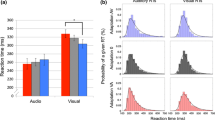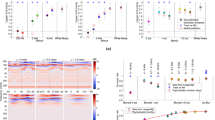Abstract
It is well known that the detection thresholds for stationary auditory and visual signals are lower if the signals are presented bimodally rather than unimodally, provided the signals coincide in time and space. Recent work on auditory–visual motion detection suggests that the facilitation seen for stationary signals is not seen for motion signals. We investigate the conditions under which motion perception also benefits from the integration of auditory and visual signals. We show that the integration of cross-modal local motion signals that are matched in position and speed is consistent with thresholds predicted by a neural summation model. If the signals are presented in different hemi-fields, move in different directions, or both, then behavioural thresholds are predicted by a probability-summation model. We conclude that cross-modal signals have to be co-localised and co-incident for effective motion integration. We also argue that facilitation is only seen if the signals contain all localisation cues that would be produced by physical objects.








Similar content being viewed by others
References
Alais D, Burr D (2004) No direction-specific bimodal facilitation for audiovisual motion detection. Cogn Brain Res 19:185–194
Blauert J (1983) Spatial hearing. MIT Press, Cambridge, MA
Frassinetti F, Bolognini N, Ladavas E (2002) Enhancement of visual perception by crossmodal visuo-auditory interaction. Exp Brain Res 147:332–343
Graham N (1989) Visual pattern analyzers. Oxford University Press, London
Hofbauer M, Wuerger SM, Meyer GF, Roehrbein M, Schill K, Zetzsche C (2004) Catching audio-visual mice: predicting the arrival time of auditory–visual motion signals. Cogn Affect Behav Neurosci 4:241–250
Howard RJ, Brammer M, Wright I, Woodruff PW, Bullmore ET (1996) A direct demonstration of functional specialization within motion-related visual and auditory cortex of the human brain. Curr Biol 6:1015–1019
Lewis JW, Beauchamp MS, DeYoe EA (2000) A comparison of visual and auditory motion processing in human cerebral cortex. Cereb Cortex 10:873–888
McDonald JJ, Teder-Sälejärvi WA, Hillyard SA (2000) Involuntary orienting to sound improves visual perception. Nature 407:906–908
Meese T, Andersen SJ (2002) Spiral mechanisms are required to account for summation of complex motion components. Vision Res 42:1073–1080
Meredith MA, Stein BE (1996) Spatial determinants of multisensory integration in cat superior colliculus. J Neurophysiol 75:1843–1857
Meredith MA, Nemitz JW, Stein BE (1987) Determinants of multisensory integration in superior colliculus neurones. I. Temporal factors. J Neurosci 10:3215–3229
Meyer G, Wuerger S (2001) Cross-modal integration of auditory and visual motion signals. Neuroreport 12:2557–2600
Mullen KT, Sankeralli MJ (1998) Evidence for the stochastic independence of the blue-yellow, red-green and luminance detection mechanisms revealed by subthreshold summation. Vision Res 39:733–745
Quick RF (1974) A vector magnitude model of contrast detection. Kybernetik 16:65–67
Röhrbein F, Zetzsche C (2000) Auditory–visual interactions and the covariance structure generated by relative movements in natural environments. In: Guidati G, Hunt H, Heiss A (eds) Proceedings of the 7th International Congress on Sound and Vibration. International Institute of Acoustics and Vibration. Kramer Technology Publishing, Munich, pp 2427–2434
Sanabria D, Soto-Faraco S, Spence C (2004) Exploring the role of visual perceptual grouping on the audiovisual integration of motion. Neuroreport 15:2745–2749
Soto-Faraco S, Lyons J, Gazzaniga M, Spence C, Kingstone A (2002) The ventriloquist in motion: illusory capture of dynamic information across sensory modalities. Cogn Brain Res 14:139–146
Soto-Faraco S, Kingstone A, Spence C (2003) Multisensory contributions to the perception of motion. Neuropsychologia 41:1847–1862
Soto-Faraco S, Spence C, Kingstone A (2004) Moving multisensory research along: motion perception across sensory modalities. Curr Direct Psychol Sci 13:29–32
Spence C, Driver J (1996) Audiovisual links in endogenous covert spatial attention. J Exp Psychol Hum Percept Perform 22(4):1005–1030
Spence C, Driver J (1997) Audiovisual links in exogenous covert spatial orienting. Percept Psychophys 59:1–22
Stein BE, Meredith MA (1993) The merging of the senses. MIT Press, Cambridge, MA
Tyler CW, Chen C-C (2000) Signal detection theory in the 2AFC paradigm: attention, channel uncertainty and probability summation. Vision Res 40:3121–3144
Wallace MT, Stein BE (1997) Development of multisensory neurons and multisensory integration in cat superior colliculus. J Neurosci 17:2429–2444
Wallace MT, Stein BE (2001) Sensory and multisensory responses in the newborn monkey superior colliculus. J Neurosci 21:8886–8894
Wallace MT, Meredith MA, Stein BE (1992) Integration of multiple sensory modalities in cat cortex. Exp Brain Res 91:484–488
Wallace MT, Meredith MA, Stein BE (1998) Multisensory integration in the superior colliculus of the alert cat. J Neurophysiol 80:1006–1010
Watson AB, Pelli D (1983) QUEST: a Bayesian adaptive psychometric method. Percept Psychophys 33:113–120
Wuerger SM, Hofbauer M, Meyer GF (2003) The integration of auditory and visual motion signals at threshold. Percept Psychophys 65:1188–1196
Acknowledgements
This work was supported by the EU TMR projects SPHEAR and HOARSE and by the Royal Society. We are grateful to the subjects who took part in the experiments.
Author information
Authors and Affiliations
Corresponding author
Rights and permissions
About this article
Cite this article
Meyer, G.F., Wuerger, S.M., Röhrbein, F. et al. Low-level integration of auditory and visual motion signals requires spatial co-localisation. Exp Brain Res 166, 538–547 (2005). https://doi.org/10.1007/s00221-005-2394-7
Received:
Accepted:
Published:
Issue Date:
DOI: https://doi.org/10.1007/s00221-005-2394-7




